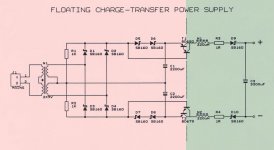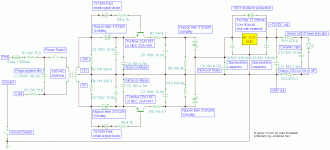Most chips run on a unipolar 5 V supply, making 0 dBFS measure at 1.8 Vrms. That should be plenty compared to the line level standard of 0.3 Vrms.Vout DACs are normally already at 2Vrms out.
The old Vout DACs like AK4396 has 1Vrms with a DC voltage offset.
The new ones like ES9023 or PCM5102 has 3.3V +Vs but 2Vrms Vout, using an internally generated -Vs.
Patrick
The new ones like ES9023 or PCM5102 has 3.3V +Vs but 2Vrms Vout, using an internally generated -Vs.
Patrick
Hello Patrick,
your work is very interesting.
I think that a lot of people are interested to try your circuit with ES9018.
Do you have any suggestion or indication?
Ciao
Guglielmo
your work is very interesting.
I think that a lot of people are interested to try your circuit with ES9018.
Do you have any suggestion or indication?
Ciao
Guglielmo
See post#123, 125, 127.
They contain all the information that will guide you to an answer.
Patrick
They contain all the information that will guide you to an answer.
Patrick
> Is SEN your current ultimate sounding I/V or It wins because of simplicity
It is what I shall be using myself.
I don't use words like best or ultimate. Else I can stop.
Patrick
good to hear that
would you please tell us what type I/V you were using before SEN
I suggest that you are doing with pcm1704
I have a folded cascode circuit which was posted before using BF862.
In comparison, the SEN / CEN is much simpler, and lower in distortion.
Since you can only buy the evaluation pack, you will have both SEN & CEN PCBs to compare for yourself.
🙂
Patrick
In comparison, the SEN / CEN is much simpler, and lower in distortion.
Since you can only buy the evaluation pack, you will have both SEN & CEN PCBs to compare for yourself.
🙂
Patrick
I am worried about floating PS
can we use ordinary +-18V with ground
so 1 kit (stereo) at 50 euro will Include both converters and parts ?
can we use ordinary +-18V with ground
so 1 kit (stereo) at 50 euro will Include both converters and parts ?
No you can't use ground referenced supplies. It helps to think about capacitors as short circuits for AC then you will see that the drains of the fets (in the complimentary version) will move around with the superimposition of the voltage across the I/V resistor.
I don't like it either since any capacitance from either "leg" of the supply to ground will be charged by the voltage at the output of the I/V.
But its performance is so superb for such a simple circuit that I wouldn't hold that against it.
I don't like it either since any capacitance from either "leg" of the supply to ground will be charged by the voltage at the output of the I/V.
But its performance is so superb for such a simple circuit that I wouldn't hold that against it.
The floating supply does not float more than the output across R_iv.
So if you are not afraid of twisted wires at the output, you should not be afraid of any capacitance of the supply lines to Gnd.
In the test PCB we measured at Jan Didden's, we did not paid any attention to wiring and have them all over the place.
Yet the performance is there for all to see.
Patrick
So if you are not afraid of twisted wires at the output, you should not be afraid of any capacitance of the supply lines to Gnd.
In the test PCB we measured at Jan Didden's, we did not paid any attention to wiring and have them all over the place.
Yet the performance is there for all to see.
Patrick
If you don't like using floating supplies (I use them for circlotrons all the time) and insists on using fixed rails,
you can build the CEN Current Mirror circuit, with 10 transistors in total, higher noise and distortions.
Easy enough to modify my published PCB layout and make one yourself.
As said, Joachim's idea. So no PCBs from us for the CEN CM.
Patrick
you can build the CEN Current Mirror circuit, with 10 transistors in total, higher noise and distortions.
Easy enough to modify my published PCB layout and make one yourself.
As said, Joachim's idea. So no PCBs from us for the CEN CM.
Patrick
I showed a mirror with approximately the same amount of distortion as your circuits. The noise issue can be solved too with cascoding but then it is not simple any more.
I agree that a floating supply is not a problem to make. The easiest are buffered batteries or accumulators.
Somewhere in my files i have a design for a floating low noise supply that can be fed by a conventional mains transformer. When i can dig it up i will publish it if you like.
I agree that a floating supply is not a problem to make. The easiest are buffered batteries or accumulators.
Somewhere in my files i have a design for a floating low noise supply that can be fed by a conventional mains transformer. When i can dig it up i will publish it if you like.
> The easiest are buffered batteries or accumulators.
That was what I used at Jan's place.
> When i can dig it up i will publish it if you like.
Please. 100%.
I think many others would be interested also.
Patrick
That was what I used at Jan's place.
> When i can dig it up i will publish it if you like.
Please. 100%.
I think many others would be interested also.
Patrick
Hello Patrick,
I red your posts about high current Dacs like ES9018, and I'd like to know if you can sell also Sen or CEn with more pairs of Jfets?
Thanks
Guglielmo
I red your posts about high current Dacs like ES9018, and I'd like to know if you can sell also Sen or CEn with more pairs of Jfets?
Thanks
Guglielmo
>Somewhere in my files i have a design for a floating low noise supply that can be fed by a conventional mains transformer.
... very interested, indeed!
... very interested, indeed!
2 Pairs of 2SK170/2SJ74 or 2 pairs of 2SK369V is AFAIK sufficient for ES9018.
This is already supported by the current PCBs.
Patrick
This is already supported by the current PCBs.
Patrick
For the basic principle something as old as me.
Or using a few more parts.
Attachments
Interesting.Or using a few more parts.
The circuit on the left would not be covered by U.S. Patent 2,895,059 because it doesn't have the dummy load and does not use the center tap as ground. However, the circuit on the left is the one that I would intuitively build.
The circuit on the right does indeed look like an actively regulated version of 2,895,059 because there appears to be a dummy load (active, at that) and ground is taken from the center tap like in the patent. ... EDIT: Oops, that's not a dummy load. The circuit on the right is also not similar to the patent mentioned above.
Both examples would have leakage current to ground which patent 2,895,059 minimizes with its dummy load.
Last edited:
- Home
- Source & Line
- Digital Line Level
- Zen -> Cen -> Sen, evolution of a minimalistic IV Converter


